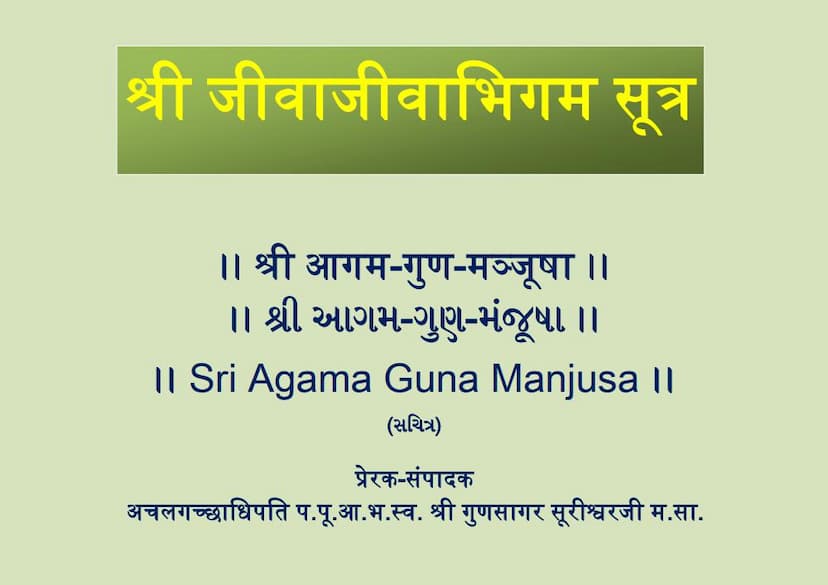Agam 14 Upang 03 Jivabhigam Sutra Shwetambar Agam Guna Manjusha
Added to library: September 1, 2025

Summary
This Jain text, titled "Agam 14 Upang 03 Jivabhigam Sutra" from the "Guna Manjusha" series, compiled by Acharya Gun Sagar Surishwarji, provides a comprehensive overview of the 45 Agamas according to the Shwetambar tradition. It serves as an introductory guide to these foundational Jain scriptures.
The text is structured into five main sections, outlining the different categories of Agamas:
I. Eleven Angas (Principal Scriptures): This section briefly describes the content and scope of each of the eleven Angas. It highlights their primary focus, number of sections (Shrutkandhas), lessons (Adhyayanas), and estimated number of verses (Shlokas). Key Angas mentioned include:
- Acharanga Sutra: Focuses on the conduct of monks and householders.
- Sutrakritanga Sutra: Discusses various philosophical viewpoints and the teaching of entities.
- Sthananga Sutra: Details the classification of objects from one to ten, primarily from the perspective of calculation.
- Samavayanga Sutra: Similar to Sthananga, it enlists objects from one to crores, acting as a compendium.
- Vyakhya Prajnapti Sutra (Bhagavati Sutra): The largest scripture, it contains questions posed by Gautama Ganadhara to Lord Mahavira and their solutions, covering all four Angas.
- Jnatadharmakathanaga Sutra: Deals with religious discourses and contains narratives.
- Upasaka Dasanga Sutra: Describes the twelve vows and the lives of ten great lay disciples, incorporating both religious discourse and conduct.
- Antakṛddaśānga Sutra: Primarily focuses on religious discourses, detailing the lives of liberated souls.
- Anuttaraupapātikadaśānga Sutra: Contains biographies of great lay disciples who achieved celestial status and eventually liberation.
- Prashna Vyakaraṇa Sutra: Answers questions posed by various beings, focusing on the ways of conduct and the principles of influx (Ashrava) and control (Samvara).
- Vipaka Sutra: Details the consequences of actions, describing the lives of ten sinful and ten virtuous souls.
II. Twelve Upangas (Subordinate Scriptures): This section lists and briefly describes twelve Upangas, which are considered complementary to the Angas. Examples include:
- Aupapatika Sutra: An Upanga of Acharanga, describing cities, austerities, and various teachings.
- Rajapraśnīya Sutra: An Upanga of Sutrakritanga, narrating the story of King Pradesi and devotion.
- Jivabhigama Sutra: An Upanga of Sthananga, analyzing souls and non-souls, and detailing the veneration by a deity. This section is quite extensive, discussing different classifications of souls (Jiva and Ajiva) and their characteristics.
- Pannavana Sutra: An Upanga of Samavayanga, describing 36 topics.
- Surya Prajnapti Sutra & Chandra Prajnapti Sutra: These focus on astronomical calculations, movements of celestial bodies, seasons, etc.
- Jambudvipa Prajnapti Sutra: Details the Jambu continent, its features, and its six continents (Aras).
- Nirayavali Sutra, Kalpavatamsaka Sutra, Pushpiya Upanga Sutra, Pushpaculika Upanga Sutra, Vṛṣṇidaśā Upanga Sutra: These are collectively referred to as the "Nirayavali Panchaka" and deal with narratives of hellish beings, lineages, and previous births.
III. Ten Payanna Sutras (Minor Scriptures/Miscellanies): This section enumerates ten Payanna Sutras, covering various aspects of Jain doctrine and practice. Some of these include:
- Atura Pratyakhyana Sutra: Deals with final religious practices and improving one's death.
- Bhakta Parigya Sutra: Describes different types of scholarly deaths.
- Suryaprajnapti Sutra and Chandraprajnapti Sutra: (Also listed under Upangas, this reiterates their astronomical focus).
- Jambudvipa Prajnapti Sutra: (Also listed under Upangas, reiterates its geographical focus).
- Nirayavali Sutra: Discusses wars and their consequences leading to hellish existences.
- Kalpa Vatamsaka Sutra: Biographies of princes.
- Pushpika Upanga Sutra & Pushpaculika Upanga Sutra: Topics related to celestial beings and their previous lives.
- Vṛṣṇidaśā Upanga Sutra: Stories related to the Vṛṣṇi lineage.
- Tandula Vaiyārika Sutra: Discusses detachment and spiritual life.
- Chandavijaya Sutra: Focuses on improving one's death through practice.
- Devendra Stava Sutra: Hymns sung by Indra.
- Maranasamadhi Sutra: Detailed description of final religious practices.
- Mahapratyakhyana Sutra: Practices for monks at the time of death.
- Ganividya Sutra: Summarizes astrological treatises.
IV. Six Cheda Sutras (Disciplinary Scriptures): This section lists six Cheda Sutras, which deal with disciplinary rules, exceptions, and expiations (Alochana). It emphasizes that the study of these texts is restricted to highly qualified and disciplined monks. These include:
- Nishitha Sutra
- Mahanishitha Sutra
- Vyavahara Sutra
- Jita Kalpa Sutra
- Pancha Kalpa Sutra
- Dasa Shrutaskandha Sutra
V. Four Mula Sutras (Root Scriptures): This section lists four foundational Mula Sutras, which are essential for the practice of Jainism.
- Dashavaikalika Sutra: Considered a nectar lake for monks and nuns in the fifth era, containing lessons and annexures.
- Uttaradhyayana Sutra: Contains the final sermons of Lord Mahavira, detailing detachment and the conduct of monks.
- Niryukti Sutra: Discusses conduct and rules, including Pind Niryukti which explains methods of receiving food and avoiding faults.
- Avashyaka Sutra: Describes six essential daily duties for all fourfold Jain community members: Samayika, Chaturvimsati, Vandana, Pratikramana, Kayotsarga, and Pratyakhyana.
VI. Two Chulikas (Appendices/Addenda):
- Nandi Sutra: Contains praise for Lord Mahavira, similes for the Sangha, names of Tirthankaras and Ganadharas, and descriptions of the five types of knowledge.
- Anuyogadvara Sutra: Considered the "key" to all Agamas, it explains explanatory devices (Anuyoga) and emphasizes the path of practice through resolve and involvement.
The text also includes a detailed section on the Jivabhigama Sutra itself (under Upangas), elaborating on its classifications of souls (Jiva and Ajiva), their types, states, lifespan, qualities, and their manifestations across various realms. It delves into the intricacies of different life forms, from one-sensed beings to five-sensed beings, including hellish beings, celestial beings, and humans, discussing their characteristics, locations, and lifespans. The original text appears to be in Prakrit, with some Gujarati explanations.